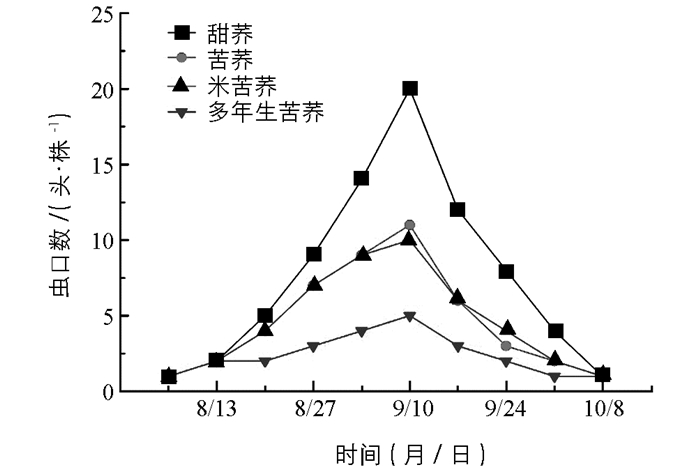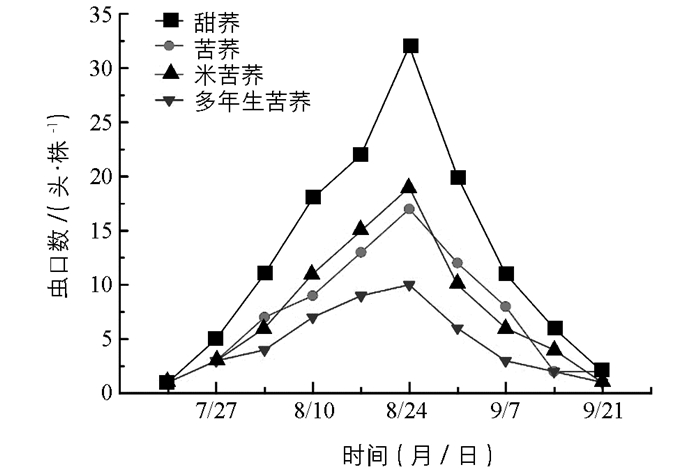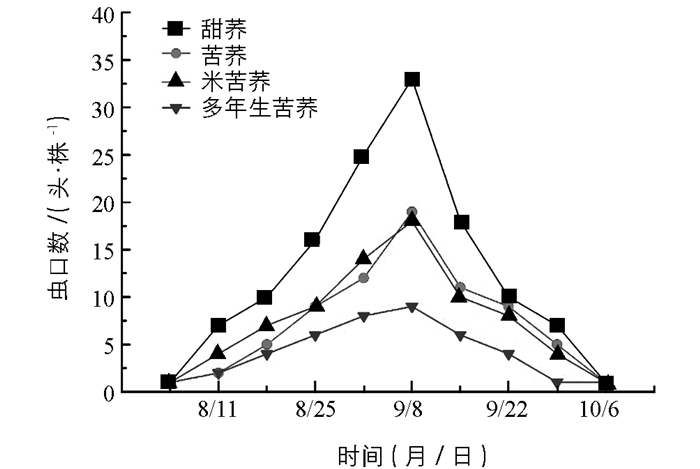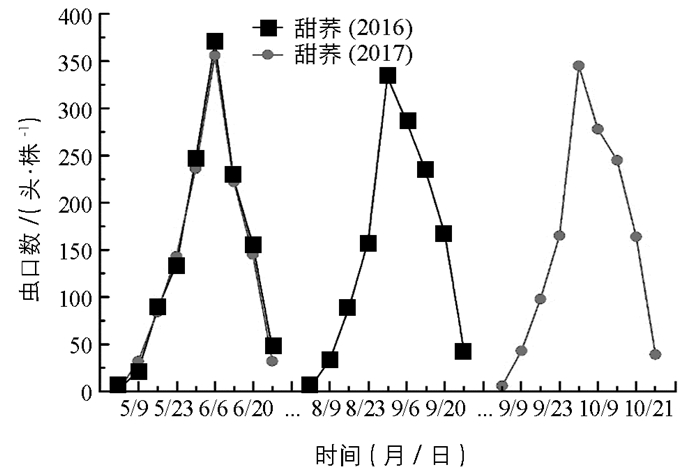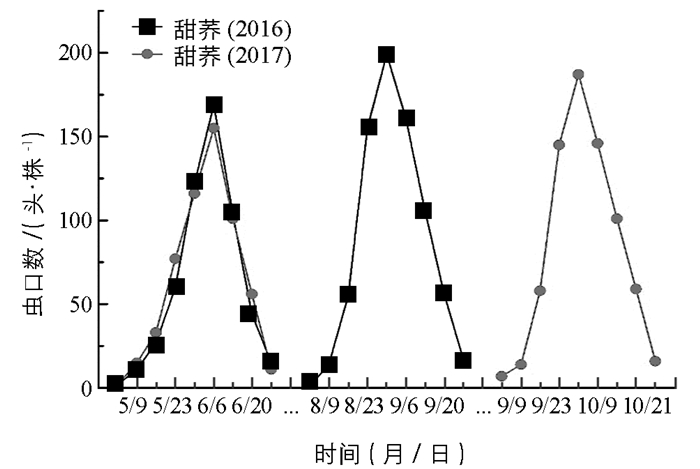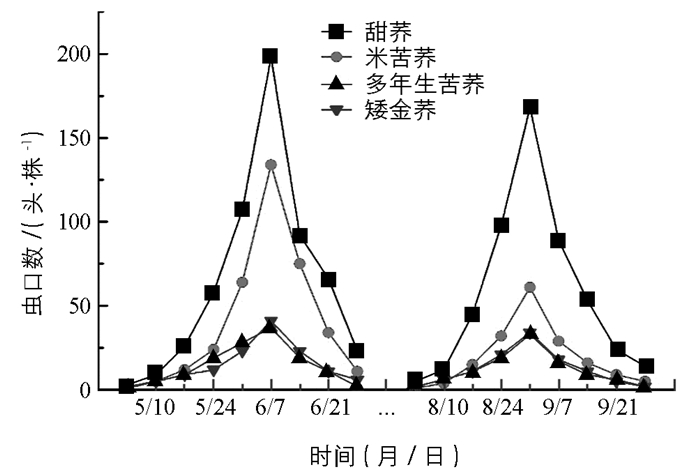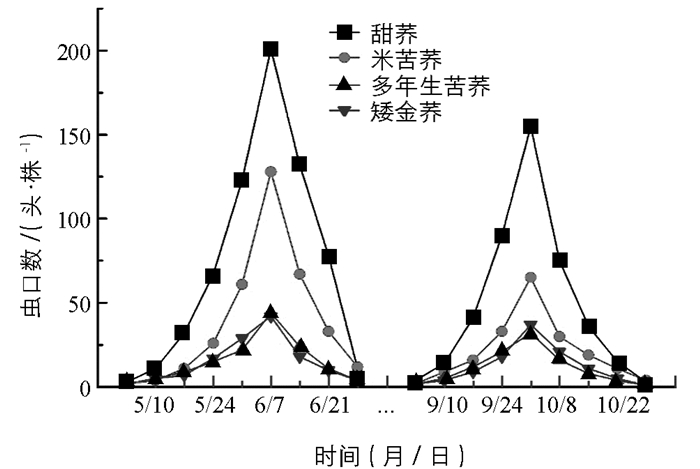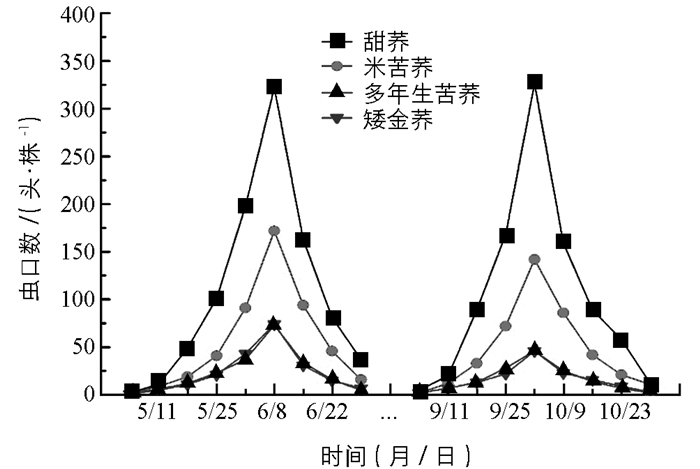-
荞麦(buckwheat)属于蓼科(Polygonaceae)荞麦属(Fagopyrum),是典型的粮药兼用养生保健作物[1],其籽粒、叶片、根茎、果壳等可加工制成糕点、茶叶、饮料、饲料等营养食品;所含的生物黄酮、芦丁、手性肌醇、植物甾醇等具有改善血液循环、降低血糖、抑制体内胆固醇吸收等药用价值;其生育期短、适应性强、耐贫瘠等特点常作为救灾的先锋作物;甜荞花期长、开花多、蜜腺发达等特点常作为养蜂业重要的蜜源作物[2-5].在现代农业生产中,荞麦在发展地方特色农业和区域经济中占有重要的地位.
近年来,随着荞麦产品多元化、种植面积扩大、轮作减少、连作增加及化学农药频繁使用等,为蚜虫的发生提供了有利条件,发生面积呈扩大趋势,危害日趋严重,且由于部分生产种植区缺乏蚜虫普查基础资料,生产上对蚜虫种类不明确,常把混合发生的多种蚜虫视为同种类来防治,因此常常达不到预期防治的效果.
蚜虫俗称腻虫或者蜜虫,属于昆虫纲(Insecta),半翅目(Hemiptera),胸喙亚目(Stemorhyncha),包括球蚜总科(Adelgoidea)和蚜总科(Aphidoidea),是世界性经济害虫,危害寄主4 700余种,危害程度随着寄主、环境不同而有所差异[6].
笔者于2016年-2017年期间对贵州省荞麦主要种植区的4个地区6个地点进行品种调查,采用5点取样调查法对蚜虫种类、数量、发生规律及危害程度等进行研究,以期为荞麦蚜虫发生的监测预警工作积累一定的资料,同时为蚜虫防治的关键时期提出参考标准.
全文HTML
-
2016-2017年在贵州省选择遵义市河闪渡村2个海拔的位置,分别是A(海拔1 219 m,东经107°52′,北纬27°33′)和B(海拔627 m,东经107°51′,北纬27°31′);六盘水市木柯村(海拔2 268 m,东经104°69′,北纬26°56′);毕节市威宁雄鹰村(海拔2 360 m,东经104°53′,北纬26°87′);贵阳市百宜镇(海拔1 345 m,东经106°53′,北纬26°52′);贵阳市贵州师范大学种植室(海拔946 m,东经106°71′,北纬26°59′)有代表性的4个地区6个种植点.在这6个种植点进行荞麦蚜虫种类的调查及其与寄主种类的关系调查,并对蚜虫优势种自然的消长规律进行系统研究.调查的荞麦种类主要是遵义以甜荞Fagopyrum esculentum为主,毕节、六盘水主要是甜荞、米苦荞F. tataricum、多年生苦荞F. tatari-cymosum、苦荞F. tataricum,贵阳是甜荞、米苦荞、多年生苦荞、矮金荞F. megaspartanium.调查时间为4月上旬荞麦长出两片新叶开始,直至荞麦收获为止.采集选择5点取样法,每个点选择10株调查,整块田共计调查50株.记录荞麦的种类、生长状况、每株荞麦的蚜虫数量、分布、危害程度等.每周调查1次,并采集蚜虫标本带回实验室进行显微镜鉴定.
-
蚜虫种类鉴定参考书和相关文献[7-9].根据危害程度确定蚜虫优势种.蚜虫发生程度级别:+发生量很少,偶见;++发生量少,较常见;+++常见,但不成灾;++++发生严重,成灾[10].
-
采用Excel 2010和Orgin 85对优势蚜虫的发生程度、高分期和趋势进行作图分析,并用SPSS 17.0对优势蚜虫在不同海拔、不同寄主上的数量和分布进行分析.
1.1. 田间调查
1.2. 蚜虫种类鉴定及优势蚜虫种类的确定
1.3. 分析方法
-
根据2016年、2017年2年对贵州省荞麦蚜虫的调查,基本明确了4个荞麦主产区6个具有代表性地点的甜荞、苦荞、米苦荞、多年生苦荞、矮金荞上造成危害的蚜虫种类、数量、分布、危害程度及优势种类的发生和消长规律.
-
对所采集的荞麦蚜虫标本进行室内镜检结果表明,所选择地区荞麦上蚜虫的种类属于半翅目Hemiptera蚜科Aphididae,包括棉蚜Aphis gossypii Glover,桃蚜Myzus persicae Sulzer和豆蚜A. craccivora Koch 3个种.主要危害甜荞,其次是米苦荞和苦荞,危害最少的是多年生荞麦和矮金荞(表 1).
-
从表 1可以看出,4个荞麦主产区棉蚜和桃蚜均有分布,但是桃蚜在甜荞上发生量大,危害最严重,苦荞和米苦荞危害较为严重,多年生苦荞和矮金荞危害不严重;棉蚜虽然分布范围广,但是在各产区的荞麦上发生量少,较常见,对荞麦不造成灾害;豆蚜仅在甜荞上有零星发现,对荞麦不造成危害.因此可见,桃蚜是4个荞麦产区的优势害虫.
-
1) 调查发现桃蚜危害甜荞、苦荞和米苦荞时,从荞麦长出两片新叶开始就会出现,偶能看见,在荞麦生长到4~6叶后较能常见,8叶至开花时期危害最为严重.刚开始主要分布在叶背脉络两侧取食,后逐渐分布于整个叶片、茎秆上、新叶和花上,卵多产于茎秆、嫩叶和花上.危害初期,在叶片正面出现白色斑点,后期随着虫口数量增加取食量增大,叶片出现大面积白斑、黄斑、褐色斑块,之后黄化、卷曲、皱缩;茎秆、嫩梢和花出现卷缩、生长缓慢、变形;分泌的米露在植物上滋生真菌,最后直至整个植物干枯死亡,严重地影响荞麦的质量和产量;桃蚜危害多年生苦荞和矮金荞时主要在茎秆和嫩花枝条上,对叶片的危害相对较小,构不成对荞麦产量的影响.
2) 调查结果显示(表 2),同一地点桃蚜在不同荞麦品种间差异具有统计学意义;发生的虫口数量,甜荞间差异极具有统计学意义,其次是苦荞和米苦荞,多年生苦荞和矮金荞间差异不具有统计学意义,说明桃蚜对不同品种荞麦的喜好性不同;在同一地区不同海拔的同一品种荞麦上,蚜虫的虫口数间差异具有统计学意义,且高海拔地区虫口数明显低于低海拔地区,说明蚜虫虫口数量与海拔有直接关系,海拔越高虫口数量越低,反之则亦然.由于遵义只种植甜荞,六盘水、毕节未种植矮金荞,贵阳未种植苦荞,因此未对遵义的米苦荞、苦荞、多年生苦荞、矮苦荞,六盘水的矮苦荞,贵阳市的苦荞进行调查.
-
通过对贵州省4个荞麦主产区的6个地点进行调查,结果显示桃蚜在不同荞麦品种上的年发生消长规律基本一致,且虫口发生数量与荞麦品种和所在种植点的海拔有直接关系.除六盘水市和毕节市不进行春播荞麦,未对其进行调查外,其他地区的虫口消长规律基本与荞麦播种规律和生长规律一致. 2016年与2017年气候基本相似,但由于2017年农历闰6月,为保证秋季播种条件与2016年一致,将秋播推迟20 d左右.春季荞麦4月中下旬播种,田间的蚜虫从5月初出现,5月下旬达到最高峰,6月下旬随着天敌增加下降至最低直至荞麦收获,如甜荞上蚜虫虫口数在遵义低海拔地区最高达369.7头/株,在高海拔地区最高达169.4头/株;在贵阳百宜地区最高达198.3头/株;在贵州师范大学地区达323.1头/株.秋季高海拔地区荞麦从7月中下旬至8月上中旬播种,蚜虫虫口数量从7月下旬至8月上旬开始出现,后逐渐上升直至8月下旬至9月上旬达到最高峰,此时如甜荞上蚜虫的虫口数量在遵义高海拔地区为198.9头/株;在毕节地区为22.4头/株;在六盘水地区为33.1头/株;在贵阳百宜地区为167.9头/株.后随着天敌增多、雨水增加、温度降低虫口数量逐渐下降,9月下旬至10月上旬逐渐下降到最低点直至荞麦收获.秋季低海拔地区荞麦从7月下旬至8月下旬播种,8月上旬至9月上旬出现蚜虫,后逐渐上升直至9月上旬至10月上旬达到最高峰时,在遵义低海拔地区为354.2头/株;在贵州师范大学地区为326.2头/株.后由于天敌增加、雨水增加、温度降低虫口数量逐渐下降,9月下旬至10月下旬达到虫口数最低直至收获(图 1-图 10).
2.1. 荞麦蚜虫种类
2.2. 荞麦优势蚜虫的确定
2.3. 桃蚜对荞麦的危害情况
2.4. 桃蚜的年发生消长规律
-
本文首次对贵州省荞麦上的蚜虫种类进行调查,结果发现贵州省荞麦主产区蚜虫主要为棉蚜、桃蚜和豆蚜3个种,目前多数学者主要是将蚜虫作为一种害虫来研究,且防治方法主要以化学农药为主,这极大地降低了对蚜虫的防治效果[11].本文对荞麦发育时期荞麦蚜虫进行调查研究,为今后荞麦生长、发育、防治等方面的研究提供了一定的参考.
本文中蚜虫消长规律整体上呈现出先上升后下降的趋势,蚜虫数量随着荞麦的发育期逐渐上升,在开花期达到最大值,后逐渐下降,这与刘芳等[12]的研究一致.因此,在开花期之前要对荞麦蚜虫进行及时的预防和防治.
不同寄主植物的气味对蚜虫的趋性作用不同,如白菜、油菜、豆角对桃蚜有明显的引诱作用,而韭菜、芹菜、辣椒对桃蚜有明显的排斥作用,茼蒿则对桃蚜无明显的趋性反应[13-15].利用植物气味的趋性作用可以对害虫进行田间防治[16],如进行田间间作荞麦可以诱导害虫减少对其他作物的危害[17].本文中桃蚜对甜荞的取食性大于其他品种的荞麦,豆蚜只取食甜荞而对其他品种的荞麦未见有取食性,说明不同品种荞麦对蚜虫的趋性作用不同,可以利用不同品种的荞麦进行田间间作达到防治害虫的目的.
蚜虫对植物的取食部位会根据植物种类和蚜虫种类的不同而不同[18],本文中桃蚜主要取食甜荞、苦荞和米苦荞的叶片、茎秆、新叶和花,而对于多年生苦荞和矮金荞主要在茎秆和嫩花枝条上取食,对叶片的取食相对较小,说明为适应生存,不同的荞麦品种会影响蚜虫的生态位.
本研究中海拔对蚜虫数量有直接影响,海拔低相对温度较高,蚜虫的发生速度较快、数量较大,反之则亦然,这与海拔越高昆虫数量越少的研究一致[19-21],因此荞麦蚜虫的预测预报及防治研究还需根据海拔高度进行判断.
此次对荞麦主产区蚜虫系统的全面研究,将对荞麦害虫资源材料进行及时地补充,根据蚜虫的消长规律,农户可根据情况在开花期前对蚜虫进行预防,遇到天气骤变,如持续高温干旱要及时进行防治,以免害虫爆发.根据荞麦品种进行合理的间作或者轮作,避免蚜虫虫口数量累计.
本课题组主要在荞麦主产区的6个点进行研究,品种、数量、时间和空间上都有一定的局限性,因此在结论和分析上难免有些欠缺,今后还需补充相关的数量来进行验证.该项调查为荞麦蚜虫的预测预报和防治研究提供了重要依据.



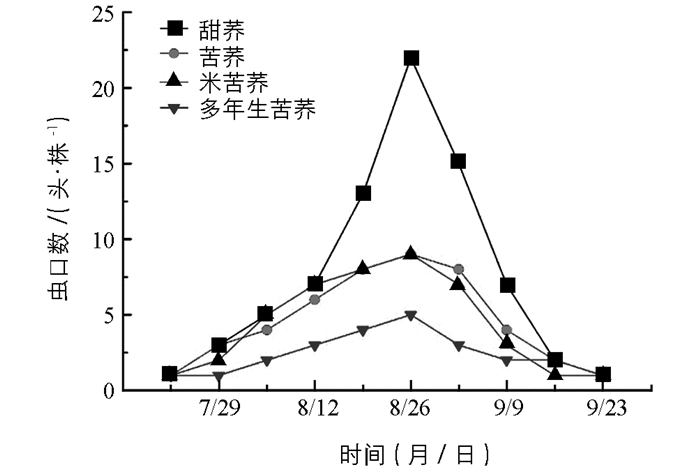
 下载:
下载:
